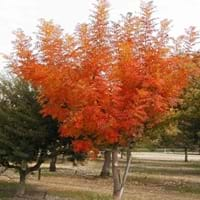Life Span
Perennial
Perennial
Origin
Caribbean, South America
China
Types
Pinks Mammoth, African Pride, Late Gold, Geffner, Hilary White
Not Available
Number of Varieties
Not Available
Habitat
Warm and moist climatic conditions
Mountains, Rocky areas
USDA Hardiness Zone
10-13
6-9
Sunset Zone
Not Available
4, 5, 6, 7, 8, 9, 10, 11, 12, 13, 14, 15, 16, 17, 18, 19, 20, 21, 22, 23
Habit
Upright/Erect
Oval or Rounded
Flower Color
Yellow green
Red, Green
Flower Color Modifier
Bicolor
Bicolor
Fruit Color
Light Green, Sea Green
Red, Blue, Green, Dark Blue, Black
Leaf Color in Spring
Light Green
Green, Light Green
Leaf Color in Summer
Light Green
Green, Dark Green
Leaf Color in Fall
Light Green
Red, Orange, Pink
Leaf Color in Winter
Light Green
Not Available
Leaf Shape
oblong or narrow-lanceolate
Pinnate
Plant Season
Summer
Summer, Fall
Sunlight
Full Sun, Partial Sun
Full Sun, Partial Sun
Growth Rate
Medium
Medium
Type of Soil
Loam, Sand
Clay, Loam, Sand
The pH of Soil
Acidic, Neutral, Alkaline
Acidic, Neutral, Alkaline
Soil Drainage
Well drained
Well drained
Bloom Time
Early Summer, Summer
Early Spring, Spring
Tolerances
Drought
Pollution, Drought, Soil Compaction
Where to Plant?
Container
Ground
How to Plant?
Seedlings
Divison, Seedlings, Stem Planting, Transplanting
Plant Maintenance
Medium
Medium
Watering Requirements
Do Not over Water, Does not require regular watering
Average Water Needs, Water once every two or three weeks, Water when top layer of soil becomes dry
In Summer
Lots of watering
Lots of watering
In Spring
Moderate
Moderate
In Winter
Average Water
Average Water
Soil pH
Acidic, Neutral, Alkaline
Acidic, Neutral, Alkaline
Soil Type
Loam, Sand
Clay, Loam, Sand
Soil Drainage Capacity
Well drained
Well drained
Sun Exposure
Full Sun, Partial Sun
Full Sun, Partial Sun
Pruning
Prune young trees into an open vase shape
Remove damaged leaves, Remove dead branches, Remove dead leaves
Fertilizers
Nitrogen
All-Purpose Liquid Fertilizer
Pests and Diseases
Anthracnose, Diplodia rot, Leaf spot
Insects, Red blotch, Rodent
Plant Tolerance
Drought
Drought, Frost
Flowers
Insignificant
Insignificant
Flower Petal Number
Single
Not Available
Foliage Texture
Medium
Medium
Foliage Sheen
Matte
Glossy
Attracts
Fruit Bats
Birds
Allergy
Oral Allergy
no allergic reactions
Aesthetic Uses
Not Used For Aesthetic Purpose
Beautification, Landscape Designing, Showy Purposes
Beauty Benefits
Promotes Healthy Hair, Promotes healthy skin
Not Available
Environmental Uses
Air purification
Air purification
Medicinal Uses
Diabetes, Diarrhea
No Medicinal Use
Part of Plant Used
Bark, Fruits, Seeds
Seeds, Stem
Other Uses
Used to make hair tonic, Used to promote healthy blood flow during menstruation
Application in Furniture, Decoration Purposes, Showy Purposes, Used in biomass, Used in Furniture
Used As Indoor Plant
No
No
Used As Outdoor Plant
Yes
Yes
Garden Design
Fruit / Fruit Tree, Shade Trees, Tropical
Shade Trees, Street Trees
Botanical Name
ANNONA squamosa
PISTACIA chinensis
Common Name
Sugar Apple
Chinese Mastic, Chinese Pistachio
In Hindi
सीताफल
चीनी पिस्ता
In German
Zuckerapfel
chinesische Pistazie
In French
Sugar Apple
pistache chinois
In Spanish
Manzana de azúcar
pistacho chino
In Greek
ζάχαρη της Apple
Κινέζοι Φιστίκι
In Portuguese
Pinha
Pistache chinês
In Polish
Cukier Jabłko
Chiński Pistacje
In Latin
Sugar Apple
LENTISCUS Chinese
Phylum
Magnoliophyta
Magnoliophyta
Class
Magnoliopsida
Magnoliopsida
Order
Magnoliales
Sapindales
Family
Annonaceae
Anacardiaceae
Clade
Angiosperms, Magnoliids
Angiosperms, Eudicots, Rosids
Subfamily
Maloideae
Not Available
Number of Species
Not Available
Not Available
Season and Care of Sugar Apple and Chinese Pistachio
Season and care of Sugar Apple and Chinese Pistachio is important to know. While considering everything about Sugar Apple and Chinese Pistachio Care, growing season is an essential factor. Sugar Apple season is Summer and Chinese Pistachio season is Summer. The type of soil for Sugar Apple is Loam, Sand and for Chinese Pistachio is Clay, Loam, Sand while the PH of soil for Sugar Apple is Acidic, Neutral, Alkaline and for Chinese Pistachio is Acidic, Neutral, Alkaline.
Sugar Apple and Chinese Pistachio Physical Information
Sugar Apple and Chinese Pistachio physical information is very important for comparison. Sugar Apple height is 460.00 cm and width 610.00 cm whereas Chinese Pistachio height is 760.00 cm and width 760.00 cm. The color specification of Sugar Apple and Chinese Pistachio are as follows:
Sugar Apple flower color: Yellow green
Sugar Apple leaf color: Light Green
Chinese Pistachio flower color: Red and Green
- Chinese Pistachio leaf color: Green and Light Green
Care of Sugar Apple and Chinese Pistachio
Care of Sugar Apple and Chinese Pistachio include pruning, fertilizers, watering etc. Sugar Apple pruning is done Prune young trees into an open vase shape and Chinese Pistachio pruning is done Remove damaged leaves, Remove dead branches and Remove dead leaves. In summer Sugar Apple needs Lots of watering and in winter, it needs Average Water. Whereas, in summer Chinese Pistachio needs Lots of watering and in winter, it needs Average Water.





